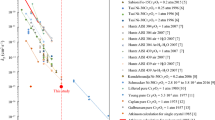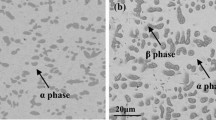Abstract
Alloys of Co-21 wt. % Cr-3 vol. % Y 2 O 3 have been prepared by a mechanical alloying method, and oxidized in oxygen at 100 Torr in the temperature range 900–1200°C. The general effects of the dispersed oxide phase are similar to those reported for nickel-base alloys: the selective oxidation of chromium to form a continuous protective Cr 2 O 3 scale is promoted; the rate of growth of Cr 2 O 3 is reduced compared to dispersoid-free alloys; the adhesion of the Cr 2 O 3 is greatly improved; and the scale-forming reaction is probably at the scale-metal interface in the alloys containing the dispersoid, whereas it is at the scale-oxygen interface in dispersoid-free alloys. This last point has not been positively demonstrated. The improvement in adhesion is of particular significance, since the scales on cobalt-base alloys are prone to spallation, and it has been possible to study the mechanism of adhesion in more detail. It appears that in dispersoid-free material the metal recedes from the scale-metal interface, leaving the scale supported on the tops of metal “peaks” but this does not happen in the alloy containing the dispersoid, either because the growth direction of the scale has been changed, or because of changes in the substrate grain size. In general, the observations support the model proposed in an early study for the oxidation of Ni-20 wt.% Cr alloys containing oxide dispersions.
Similar content being viewed by others
References
G. R. Wallwork and A. Z. Hed,Oxid. Metals 3, 229 (1971).
C. E. Lowell, D. L. Deadmore, S. J. Grisaffe, and I. L. Drell, NASA Technical Note TD D-6290 (April 1971).
C. S. Giggins and F. S. Pettit,Met. Trans. 2, 1071 (1971).
H. H. Davis, H. C. Graham, and I. A. Kvernes,Oxid. Metals 3, 431 (1971).
J. Stringer, B. A. Wilcox, and R. I. Jaffee,Oxidation of Metals 5(1), 11 (1972).
P. Kofstad and A. Z. Hed,J. Electrochem. Soc. 116, 225 (1969).
P. Kofstad and A. Z. Hed,J. Electrochem. Soc. 116, 229 (1969).
P. Kofstad and A. Z. Hed,J. Electrochem. Soc. 116, 1542 (1969).
P. Kofstad and A. Z. Hed,Werkstoffe Korrosion 21, 894 (1970).
G. C. Wood, I. G. Wright, T. Hodgkiess, and D. P. Whittle,Werkstoffe Korrosion 21, 900 (1970).
W. C. Hagel,Trans. ASM 56, 583 (1963).
J. Stringer, A. Z. Hed, G. R. Wallwork, and B. A. Wilcox, submitted toCorrosion Sci.
J. Stringer,Oxidation of Metals 5(1), 49 (1972).
Author information
Authors and Affiliations
Additional information
This work has been supported by the Naval Air Systems Command under Contract No. N00019-71-C-0079.
Rights and permissions
About this article
Cite this article
Stringer, J., Wright, I.G. The high-temperature oxidation of cobalt-21 wt.% chromium-3 vol.% Y2O3 alloys. Oxid Met 5, 59–84 (1972). https://doi.org/10.1007/BF00614619
Received:
Issue Date:
DOI: https://doi.org/10.1007/BF00614619




